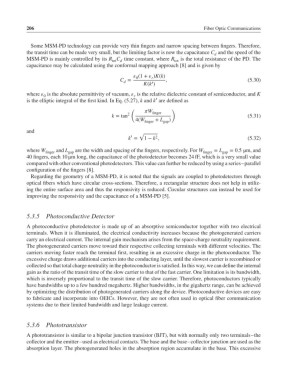Page 225 - Fiber Optic Communications Fund
P. 225
206 Fiber Optic Communications
Some MSM-PD technology can provide very thin fingers and narrow spacing between fingers. Therefore,
the transit time can be made very small, but the limiting factor is now the capacitance C and the speed of the
d
MSM-PD is mainly controlled by its R C time constant, where R tot is the total resistance of the PD. The
tot d
capacitance may be calculated using the conformal mapping approach [8] and is given by
(1 + )K(k)
0
r
C = , (5.30)
d
′
K(k )
where is the absolute permittivity of vacuum, is the relative dielectric constant of semiconductor, and K
0 r
′
is the elliptic integral of the first kind. In Eq. (5.27), k and k are defined as
( )
W finger
k = tan 2 (5.31)
4(W + L )
finger gap
and
√
′
2
k = 1 − k , (5.32)
where W finger and L gap are the width and spacing of the fingers, respectively. For W finger = L gap = 0.5 μm, and
40 fingers, each 10 μm long, the capacitance of the photodetector becomes 24 fF, which is a very small value
compared with other conventional photodetectors. This value can further be reduced by using a series–parallel
configuration of the fingers [8].
Regarding the geometry of a MSM-PD, it is noted that the signals are coupled to photodetectors through
optical fibers which have circular cross-sections. Therefore, a rectangular structure does not help in utiliz-
ing the entire surface area and thus the responsivity is reduced. Circular structures can instead be used for
improving the responsivity and the capacitance of a MSM-PD [5].
5.3.5 Photoconductive Detector
A photoconductive photodetector is made up of an absorptive semiconductor together with two electrical
terminals. When it is illuminated, the electrical conductivity increases because the photogenerated carriers
carry an electrical current. The internal gain mechanism arises from the space-charge neutrality requirement.
The photogenerated carriers move toward their respective collecting terminals with different velocities. The
carriers moving faster reach the terminal first, resulting in an excessive charge in the photoconductor. The
excessive charge draws additional carriers into the conducting layer, until the slowest carrier is recombined or
collected so that total charge neutrality in the photoconductor is satisfied. In this way, we can define the internal
gain as the ratio of the transit time of the slow carrier to that of the fast carrier. One limitation is its bandwidth,
which is inversely proportional to the transit time of the slow carrier. Therefore, photoconductors typically
have bandwidths up to a few hundred megahertz. Higher bandwidths, in the gigahertz range, can be achieved
by optimizing the distribution of photogenerated carriers along the device. Photoconductive devices are easy
to fabricate and incorporate into OEICs. However, they are not often used in optical fiber communication
systems due to their limited bandwidth and large leakage current.
5.3.6 Phototransistor
A phototransistor is similar to a bipolar junction transistor (BJT), but with normally only two terminals–the
collector and the emitter–used as electrical contacts. The base and the base–collector junction are used as the
absorption layer. The photogenerated holes in the absorption region accumulate in the base. This excessive

